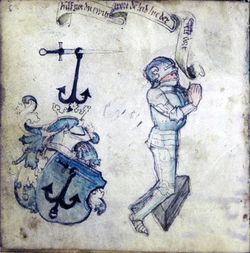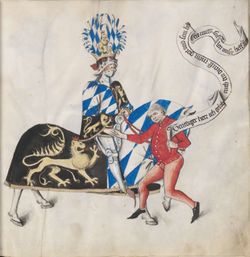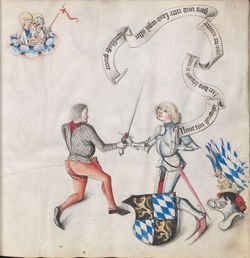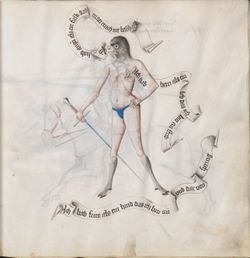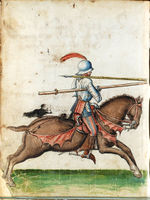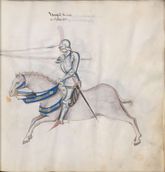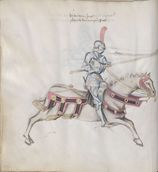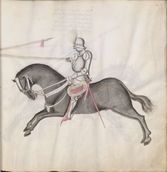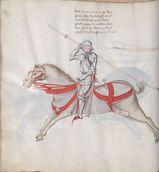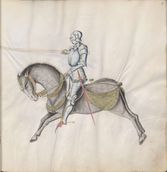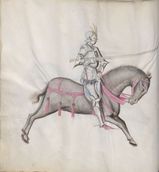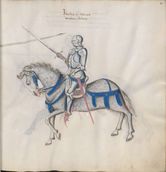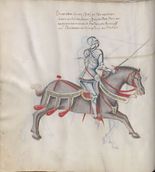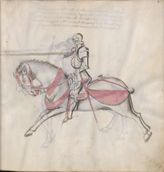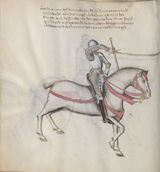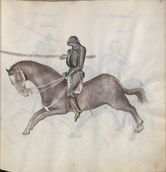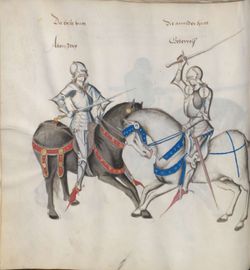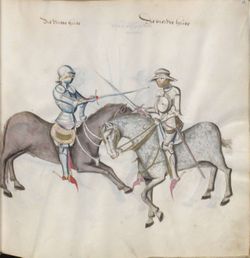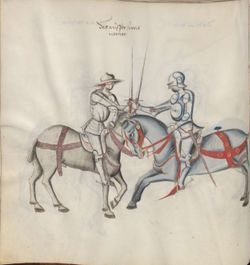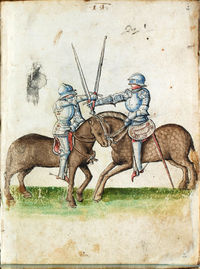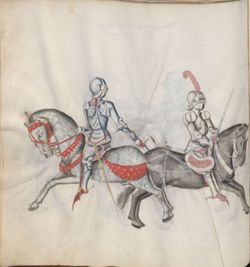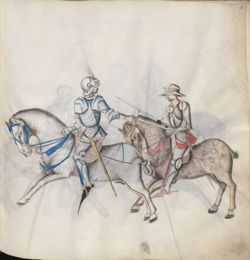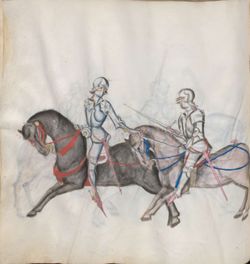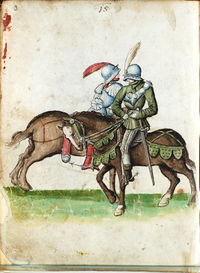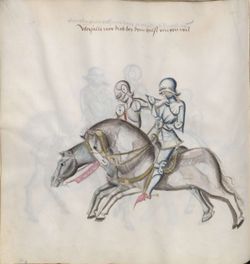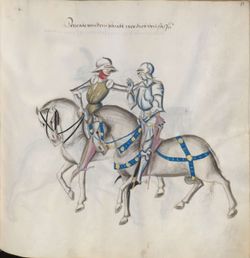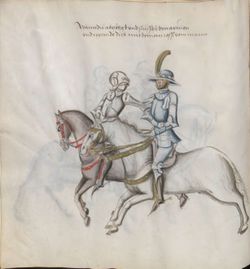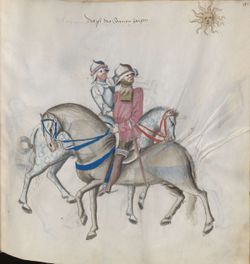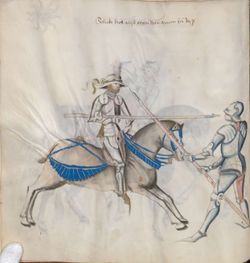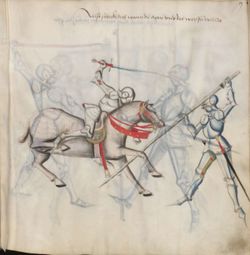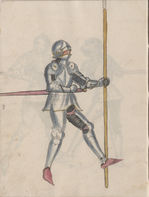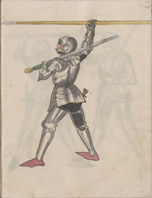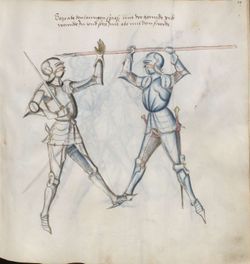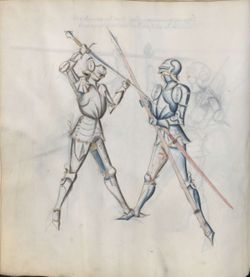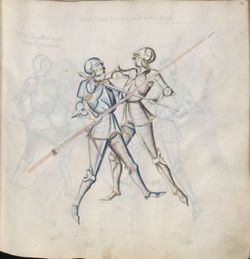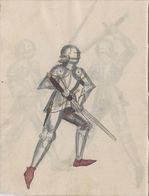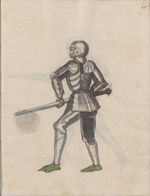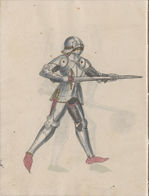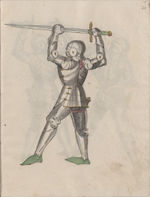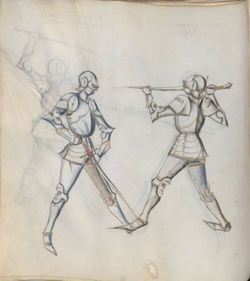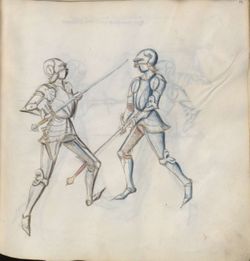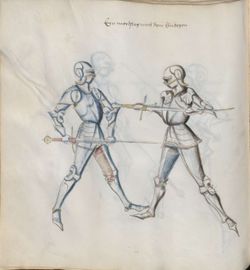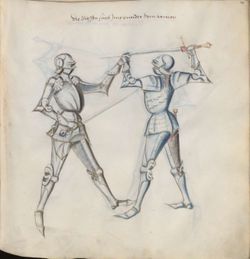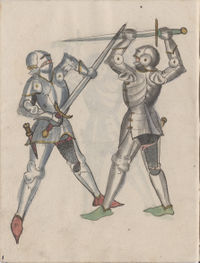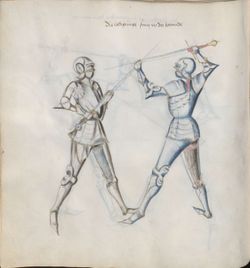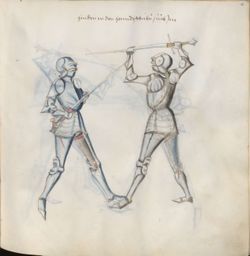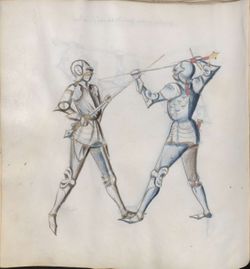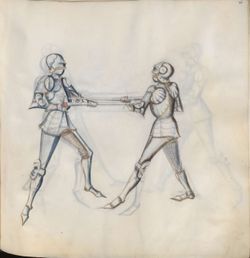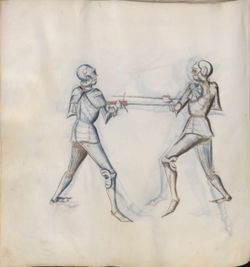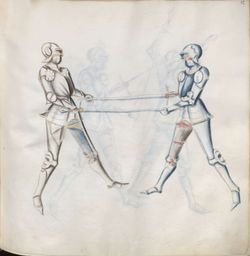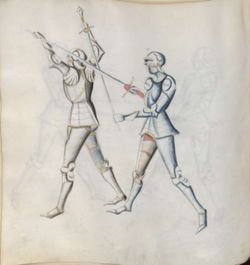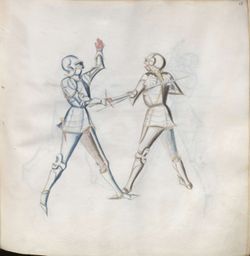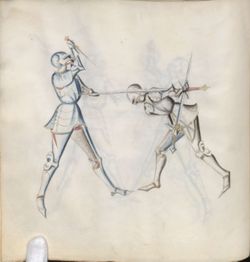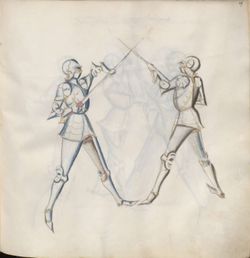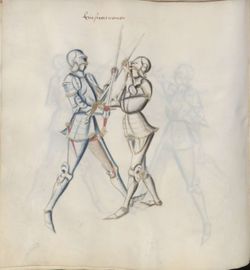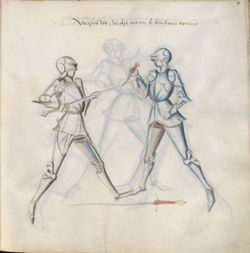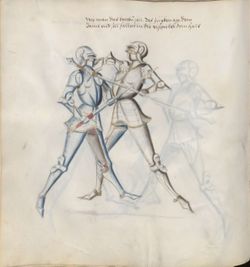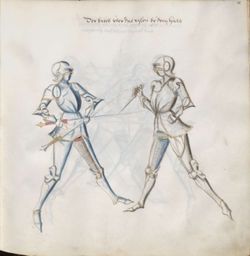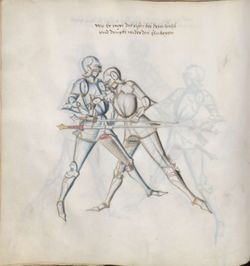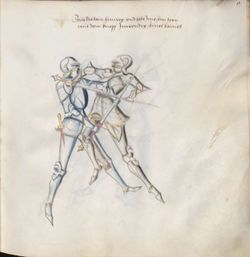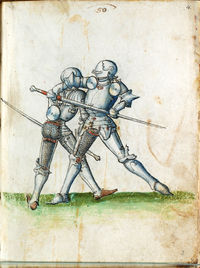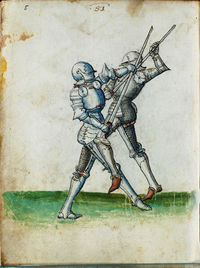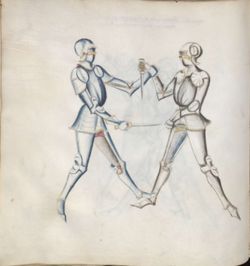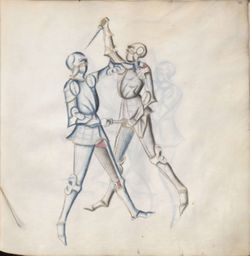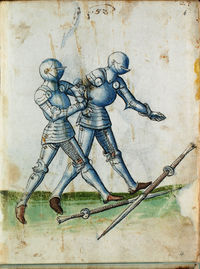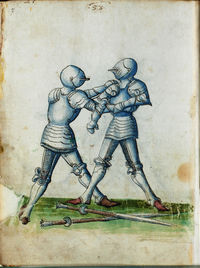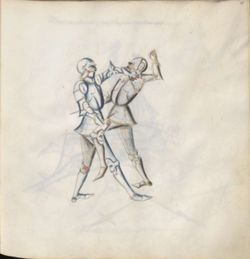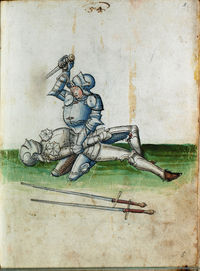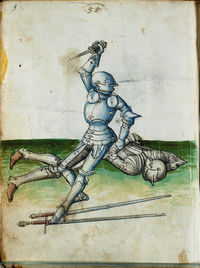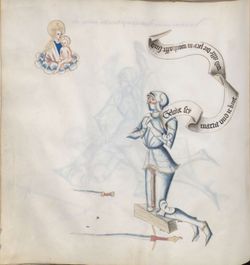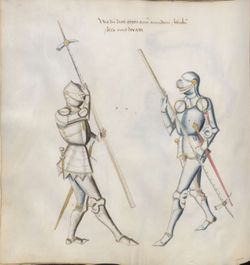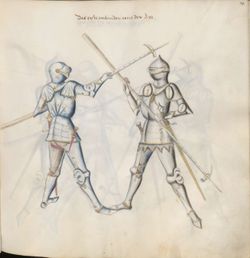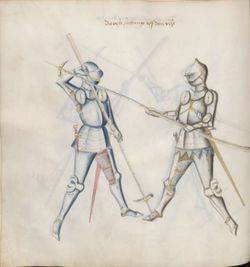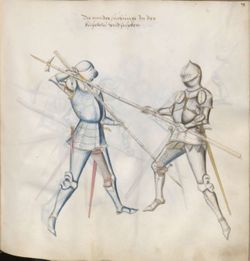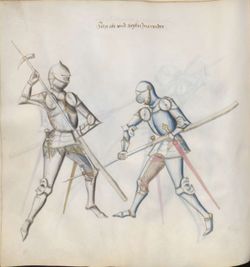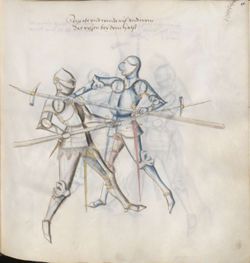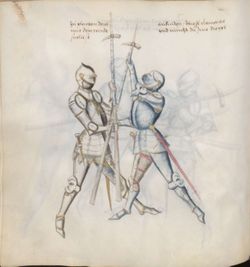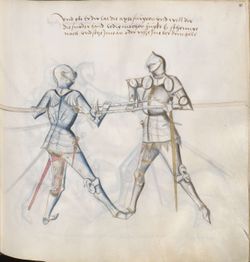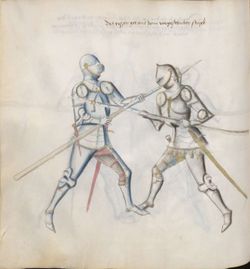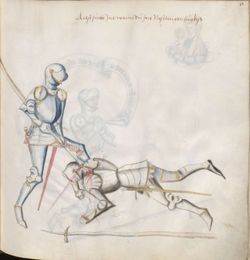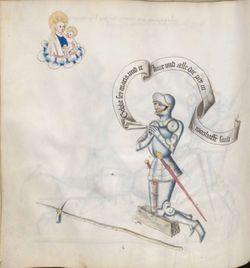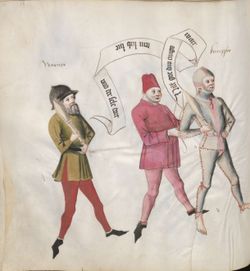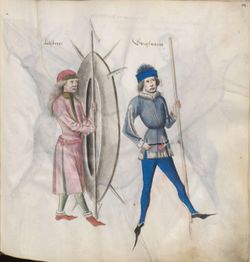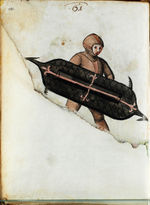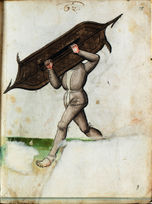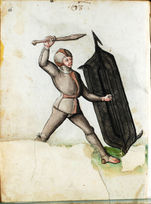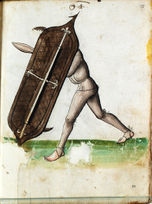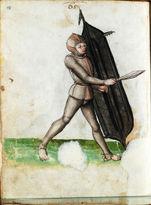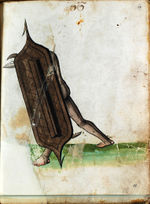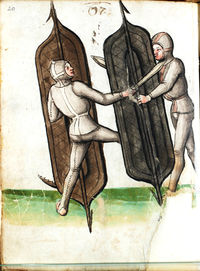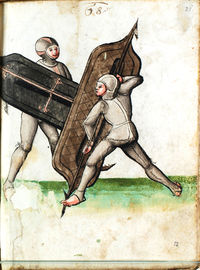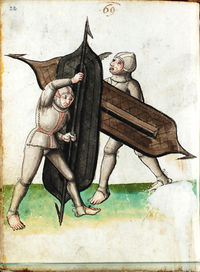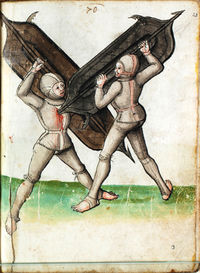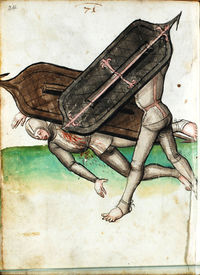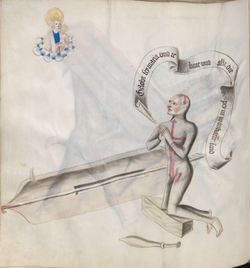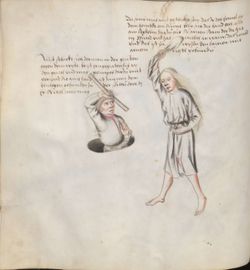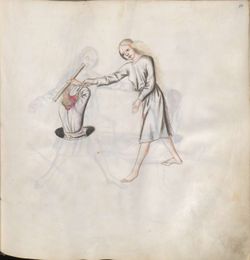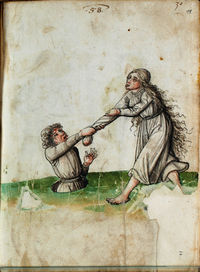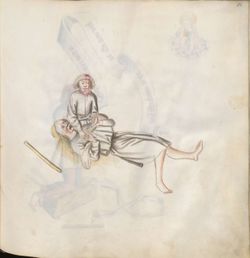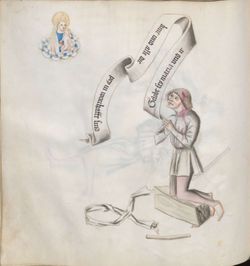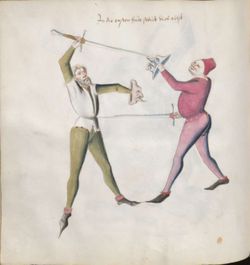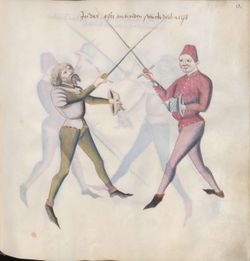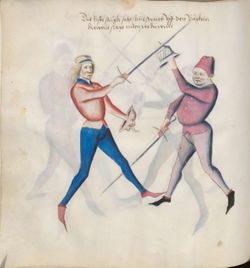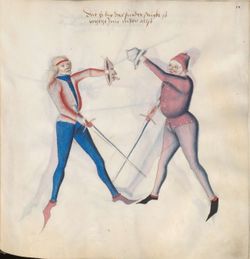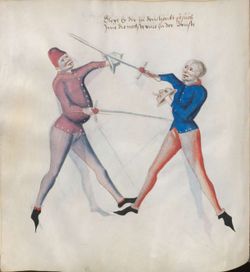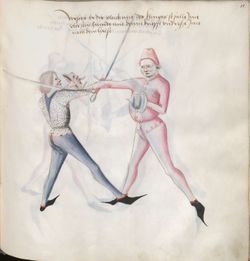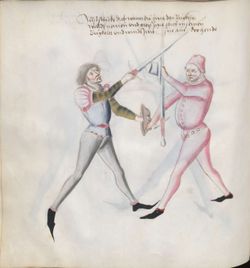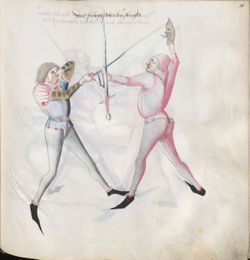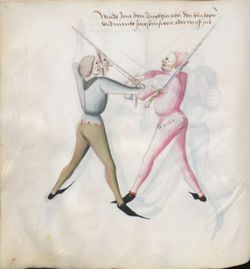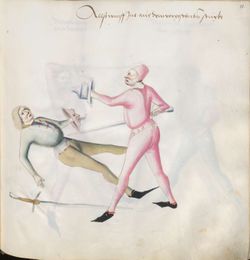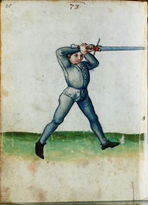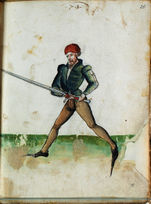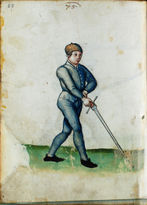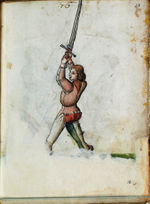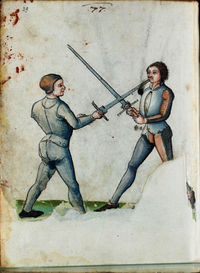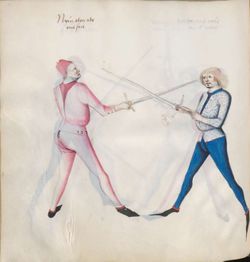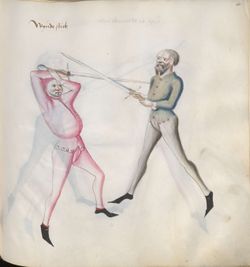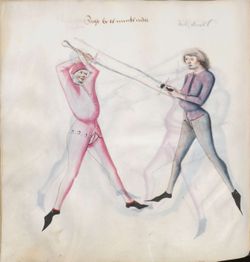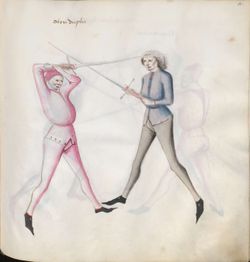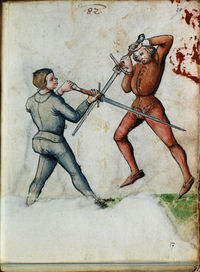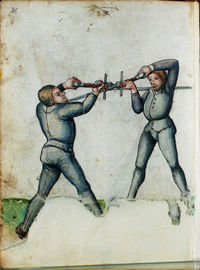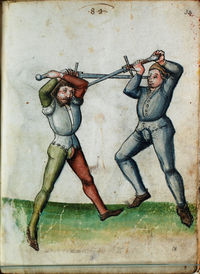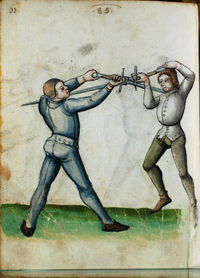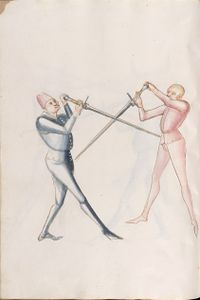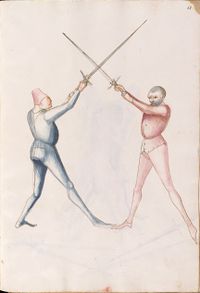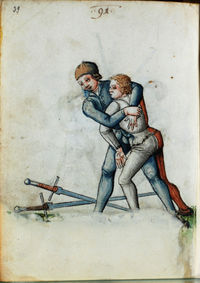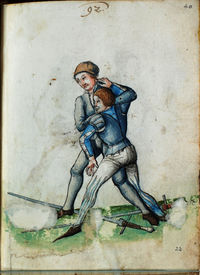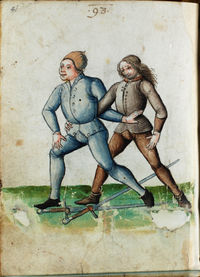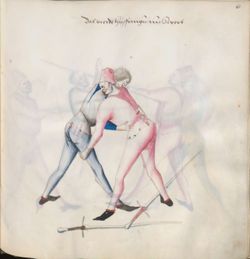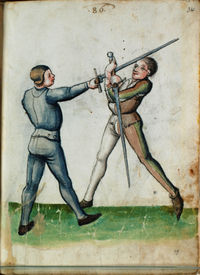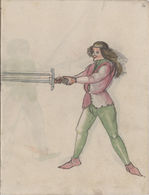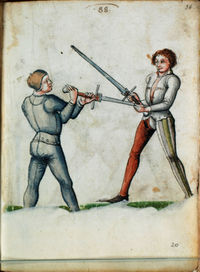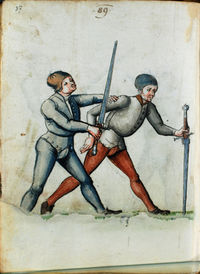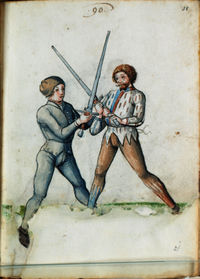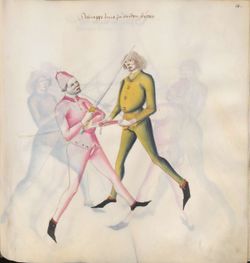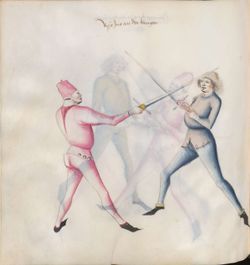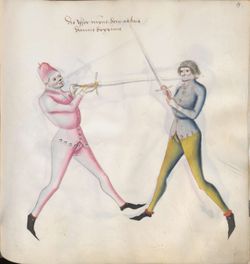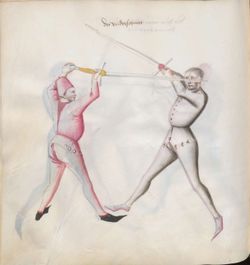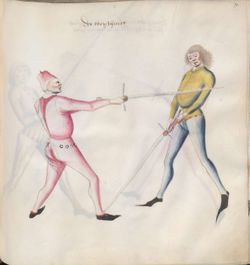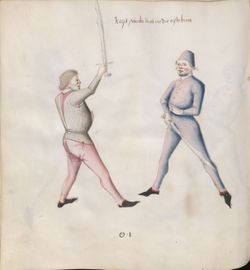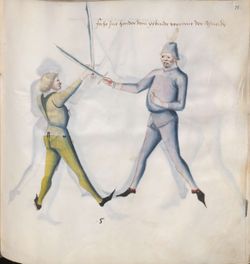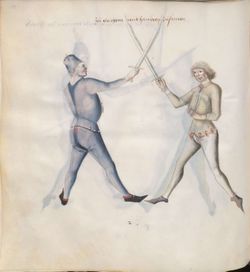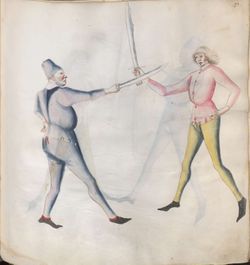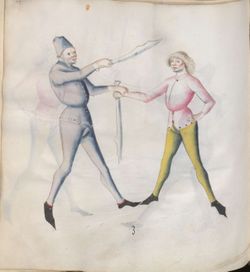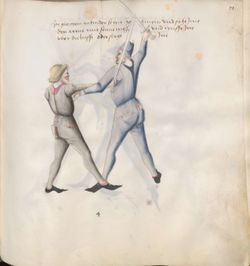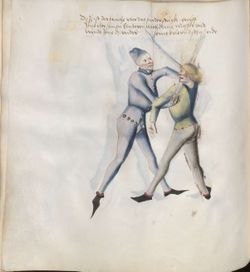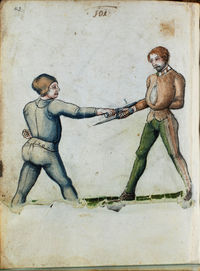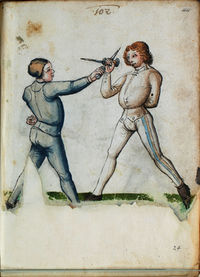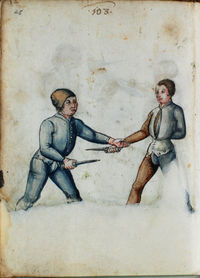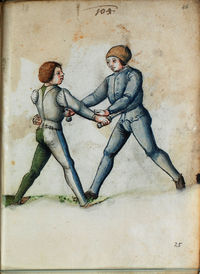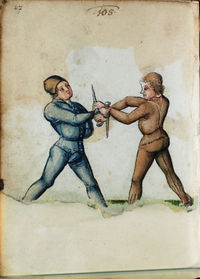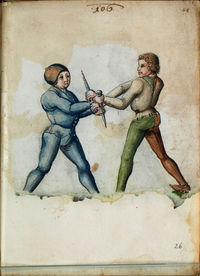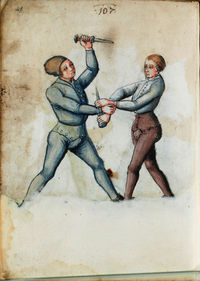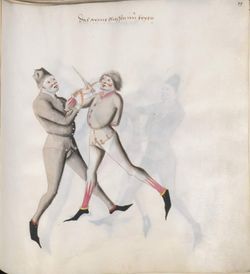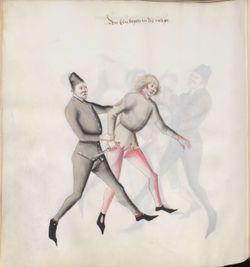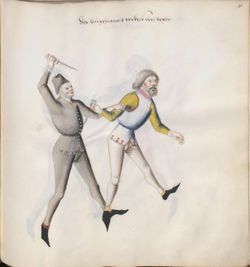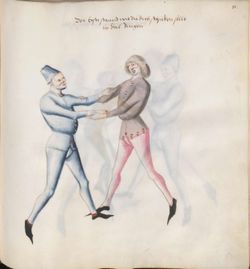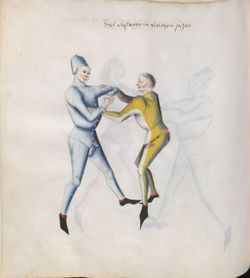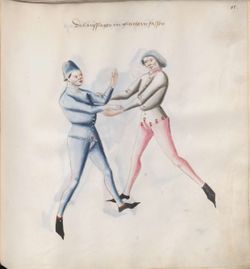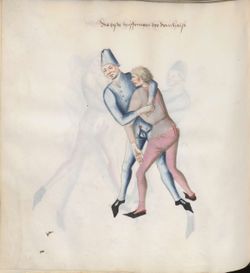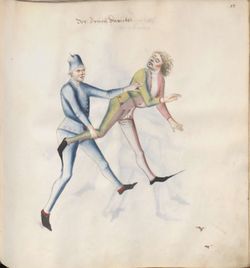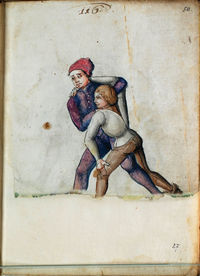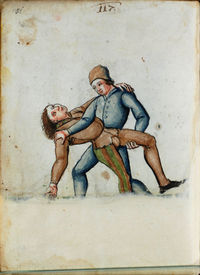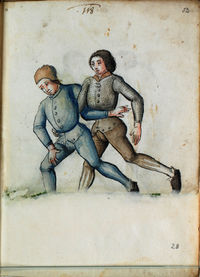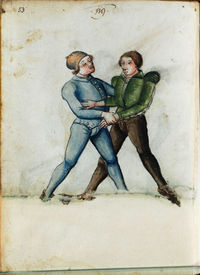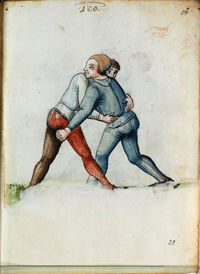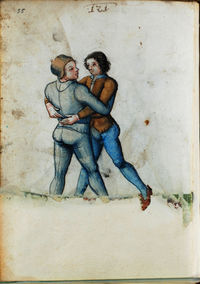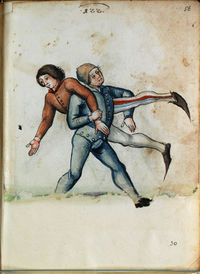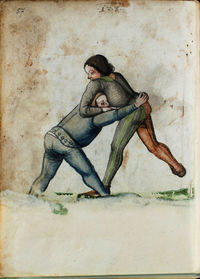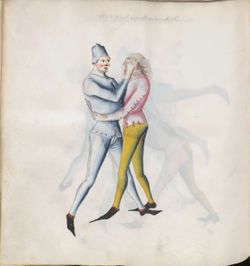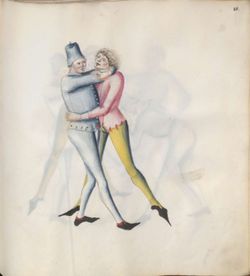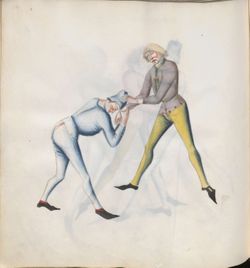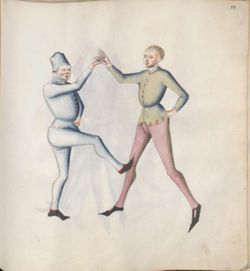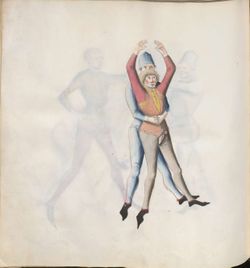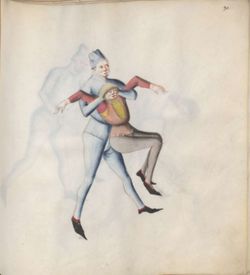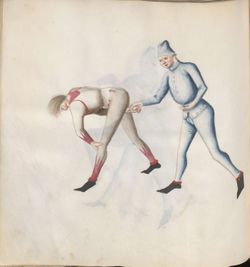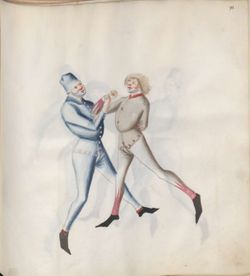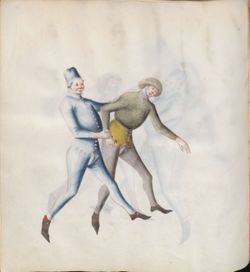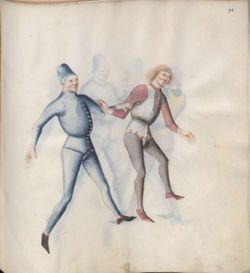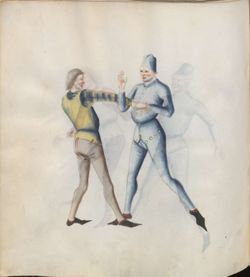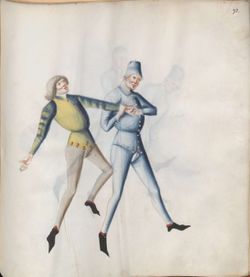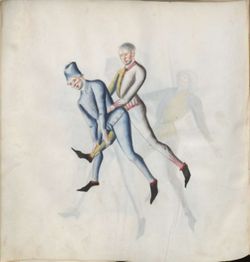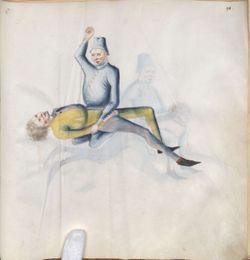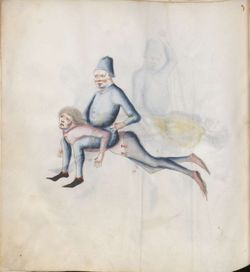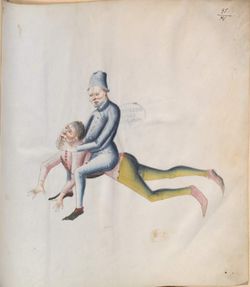|
|
You are not currently logged in. Are you accessing the unsecure (http) portal? Click here to switch to the secure portal. |
Difference between revisions of "Paulus Kal"
Cory Winslow (talk | contribs) |
|||
| Line 1,129: | Line 1,129: | ||
|- | |- | ||
! <p>Images<br/>from the [[Paulus Kal Fechtbuch (Cgm 1507)|Munich]] and [[Solothurner Fechtbuch (Cod.S.554)|Solothurn]] Versions</p> | ! <p>Images<br/>from the [[Paulus Kal Fechtbuch (Cgm 1507)|Munich]] and [[Solothurner Fechtbuch (Cod.S.554)|Solothurn]] Versions</p> | ||
| − | ! <p>{{rating|C}}<br/> | + | ! <p>{{rating|C}}<br/>[[Cory Winslow]]</p> |
! <p>[[Paulus Kal Fechtbuch (Cgm 1507)|Munich Version]] (ca. 1470){{edit index|Paulus Kal Fechtbuch (Cgm 1507)}}<br/>by [[Dierk Hagedorn]]</p> | ! <p>[[Paulus Kal Fechtbuch (Cgm 1507)|Munich Version]] (ca. 1470){{edit index|Paulus Kal Fechtbuch (Cgm 1507)}}<br/>by [[Dierk Hagedorn]]</p> | ||
! <p>[[Paulus Kal Fechtbuch (MS 1825)|Bologna Version]] (1460-1480){{edit index|Paulus Kal Fechtbuch (MS 1825)}}<br/>by [[Carsten Lorbeer]], [[Julia Lorbeer]], [[Andreas Meier]], [[Marita Wiedner]]</p> | ! <p>[[Paulus Kal Fechtbuch (MS 1825)|Bologna Version]] (1460-1480){{edit index|Paulus Kal Fechtbuch (MS 1825)}}<br/>by [[Carsten Lorbeer]], [[Julia Lorbeer]], [[Andreas Meier]], [[Marita Wiedner]]</p> | ||
| Line 1,139: | Line 1,139: | ||
|- | |- | ||
| [[File:Cgm 1507 52v.jpg|250px|center]] | | [[File:Cgm 1507 52v.jpg|250px|center]] | ||
| − | | <p> | + | | <p>In the first guard position yourself thus.</p> |
| {{paget|Page:Cgm 1507|52v|jpg}} | | {{paget|Page:Cgm 1507|52v|jpg}} | ||
| | | | ||
| Line 1,149: | Line 1,149: | ||
|- | |- | ||
| [[File:Cgm 1507 53r.jpg|250px|center]] | | [[File:Cgm 1507 53r.jpg|250px|center]] | ||
| − | | <p> | + | | <p>In the first binding-on position yourself thus.</p> |
| {{paget|Page:Cgm 1507|53r|jpg}} | | {{paget|Page:Cgm 1507|53r|jpg}} | ||
| | | | ||
| Line 1,159: | Line 1,159: | ||
|- | |- | ||
| [[File:Cgm 1507 53v.jpg|250px|center]] | | [[File:Cgm 1507 53v.jpg|250px|center]] | ||
| − | | <p>The first | + | | <p>The first technique. Catch his strike on your buckler, meanwhile strike low where you want.</p> |
| {{paget|Page:Cgm 1507|53v|jpg}} | | {{paget|Page:Cgm 1507|53v|jpg}} | ||
| | | | ||
| Line 1,169: | Line 1,169: | ||
|- | |- | ||
| [[File:Cgm 1507 54r.jpg|250px|center]] | | [[File:Cgm 1507 54r.jpg|250px|center]] | ||
| − | | <p>If he | + | | <p>If he does the previous technique to you, then parry him low thus.</p> |
| {{paget|Page:Cgm 1507|54r|jpg}} | | {{paget|Page:Cgm 1507|54r|jpg}} | ||
| | | | ||
| Line 1,179: | Line 1,179: | ||
|- | |- | ||
| [[File:Cgm 1507 54v.jpg|250px|center]] | | [[File:Cgm 1507 54v.jpg|250px|center]] | ||
| − | | <p>If he strikes | + | | <p>If he strikes to your head, then search for the nearest touch to his breast .</p> |
| {{paget|Page:Cgm 1507|54v|jpg}} | | {{paget|Page:Cgm 1507|54v|jpg}} | ||
| | | | ||
| Line 1,189: | Line 1,189: | ||
|- | |- | ||
| [[File:Cgm 1507 55r.jpg|250px|center]] | | [[File:Cgm 1507 55r.jpg|250px|center]] | ||
| − | | <p>If he | + | | <p> If he parries you simultaneously with the blade, then fall over his hand with your pommel and tear after his neck.</p> |
| {{paget|Page:Cgm 1507|55r|jpg}} | | {{paget|Page:Cgm 1507|55r|jpg}} | ||
| {{paget|Page:MS 1825|15r|jpg|blk=1}} | | {{paget|Page:MS 1825|15r|jpg|blk=1}} | ||
| Line 1,199: | Line 1,199: | ||
|- | |- | ||
| [[File:Cgm 1507 55v.jpg|250px|center]] | | [[File:Cgm 1507 55v.jpg|250px|center]] | ||
| − | | <p> | + | | <p>Position yourself thus when you want to take his buckler, and grip him inverted in his buckler and wind it from his hand.</p> |
| {{paget|Page:Cgm 1507|55v|jpg}} | | {{paget|Page:Cgm 1507|55v|jpg}} | ||
| {{paget|Page:MS 1825|15v|jpg|blk=1}} | | {{paget|Page:MS 1825|15v|jpg|blk=1}} | ||
| Line 1,209: | Line 1,209: | ||
|- | |- | ||
| [[File:Cgm 1507 56r.jpg|250px|center]] | | [[File:Cgm 1507 56r.jpg|250px|center]] | ||
| − | | <p>The | + | | <p>The previously described technique.</p> |
| {{paget|Page:Cgm 1507|56r|jpg}} | | {{paget|Page:Cgm 1507|56r|jpg}} | ||
| {{paget|Page:MS 1825|16r|jpg|blk=1}} | | {{paget|Page:MS 1825|16r|jpg|blk=1}} | ||
| Line 1,229: | Line 1,229: | ||
|- | |- | ||
| [[File:Cgm 1507 57r.jpg|250px|center]] | | [[File:Cgm 1507 57r.jpg|250px|center]] | ||
| − | | <p> | + | | <p>Thus he is thrown from the previously described technique.</p> |
| {{paget|Page:Cgm 1507|57r|jpg}} | | {{paget|Page:Cgm 1507|57r|jpg}} | ||
| {{paget|Page:MS 1825|17r|jpg|blk=1}} | | {{paget|Page:MS 1825|17r|jpg|blk=1}} | ||
Revision as of 15:19, 30 September 2015
| Paulus Kal | |
|---|---|
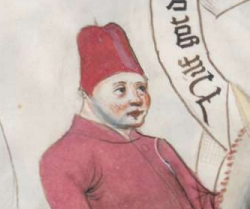 | |
| Born | ca.1420s Dingolfing, Germany |
| Died | after 1485 |
| Occupation |
|
| Patron |
|
| Movement | Society of Liechtenauer |
| Influences | |
| Influenced | Peter Falkner (?) |
| Genres | |
| Language | |
| Archetype(s) | |
| Manuscript(s) |
Gotti MS (late 1400s)
|
| First printed english edition |
Tobler, 2006 |
| Concordance by | Michael Chidester, Carsten Lorbeer, Julia Lorbeer, Andreas Meier, Marita Wiedner |
| Translations | |
Paulus Kal was a 15th century German fencing master. He wrote that he studied martial arts under Hans Stettner von Mörnsheim, and was an initiate of the tradition of Johannes Liechtenauer. He was also attached as Schirrmeister to three different courts in his career, serving in various military capacities including commanding men in at least three campaigns.[1] Perhaps his most significant legacy is an honor role of masters which he styled the Society of Liechtenauer (Geselschaft Liechtenauers). While many of these masters remain unknown, the several wrote treatises of their own and Kal's list stands as an independent confirmation of their connection to the grand master. Kal's treatise is also of interest in that it represents the first attempt to illustrate Liechtenauer's Recital (Zettel).
Little is known of Kal's early life, but from 1440 to ca. 1449 he served Ludwig IV "the Gentle" of the Wittelsbach, Count Palatine of the Rhine. In 1448, while in the count's service he participated in the defense Nuremberg, commanding a unit of wheel cannons below the gates.[2] The Nuremberg Council notes from 17 March 1449 mention that he had broken the peace of the city at that time by drawing his weapons.[2]
Kal entered the service of Ludwig IX "the Rich" of the House of Wittelsbach, Duke of Bavaria-Landshut, on 29 September 1450.[1] In 1461, he is mentioned commanding a unit of 12 marksmen.[2] From 1465 to 1475, he seems to have also maintained a secondary occupation as a toll collector in Dingolfing.[2] In November 1468, he participated in military actions on the castle Saldenburg, which was successfully taken on 4 December.[2] Kal is listed as a guest at the wedding of Ludwig's son George,[2] and continued in the duke's service until his death on 18 January 1479. Paulus Kal created the first two versions of his treatise while in the service of Ludwig IX, an uncaptioned version as well as a more elaborate presentation copy including brief explanations in German for most devices (many extracted from Liechtenauer's Recital).
On 12 February 1480, Paulus Kal entered the service of Sigismund of the House of Habsburg, Archduke of Austria and Tyrol.[1] Kal acted as one of the archduke's witnesses at a number of interrogations held on 17 October 1485 in Innsbruck, related to the witch trials being conducted by Heinrich Kramer at that time.[2] This is the final time that Kal's name appears in the histories. Several copies of Kal's treatise were created during the 1480s and 90s, but the only one which shows any indication of Kal's personal involvement is the extensive MS KK5126.
In total, Paulus Kal's teachings are preserved in at least six manuscripts written between 1460 and 1514. Aside from the three already mentioned, two other fragmentary, text-less copies also exist (one copied from the Bologna, and the other from an unknown source). A sixth version was sold at auction in Italy during the 20th century as individual leaves; this copy contains single-word captions in Latin or Italian and was likely based on either the Bologna or Vienna. In addition, Paulus Hector Mair based content in several sections of the Munich and Vienna versions of his Opus Amplissimum de Arte Athletica on Kal's treatise. Rather than using Kal's descriptions (if the copy he used had them), Mair wrote his own extensive commentary on the images. The precise set of images Mair drew upon do not appear in any of the six extant manuscripts, which may signify that there was once a seventh copy of Kal's work which has since been lost.
Contents
Treatise
Draft Translation |
Munich Version (ca. 1470) |
Bologna Version (1460-1480) |
Vienna Version (ca. 1480s) |
Gotha Version (ca. 1473-1503) |
Solothurn Version (ca. 1506-1514) |
||
|---|---|---|---|---|---|---|---|
With the help of God and of the highborn lord Duke Ludwig, Count Palatine of the Rhine, Duke of Lower and Upper Bavaria, I, Master Paulus Kal, an exponent of art, have made this book, which deals with all knightly weapons in brief succession. |
[02r] Mit hilf gottes und des hochgeporn hern herczog ludwigs pfalczgrawe peÿ rein herczog in nydern und obern bayren. Hab ich maister pauls kal ain merer der kunst das püech geordenirt in aller Ritterlicher wer auf das kurczt und auf das nachst. |
[02r] Mit hilf gottes Vnd des hoch gepornen herrn hertzog lud wigs pfaltzgrauen Bey Rein herzogen In Nidern vnd obern Bayern etc hab ich maister pauls kal ain merer der kunst das puech georniert In aller Ritterlicher wëer auf das kürtzt vnd auf das nagst |
[09r] Mit hylf gotes vnnd des hochgepornnenn hern herczog ludwigs pfalczgraffne bey rein herczog in nydern vnnd obernn bayrne hab ich maister pauls kal ain merer der chunst das puech geornyrt in aller ritterlicher wer auf das churczt vnd auf das nachst |
||||
Here begins the art that Liechtenauer has created with his society and applied with all knightly weapons. May God have mercy on him. |
Hye hebt sich an die kunst die liechtenawer mit seiner geselschafft gemacht und gepraücht hat in aller ritterliche wer das im got genädig seÿ. |
[02v] Hye hebt sich an dye kunst dye liechtenawer mit siner geselschaft gemacht vnd gepraucht hat, In aller [Ri]tterlichen weer das Im got genedig sey |
Hie hebt sich an die chunnst die liechtnawer mit seiner geselschafft gemacht vnnd gepraucht hat in aller Ritterlichenn wer das im got genädig sey |
||||
Master Johannes Liechtenauer. |
Maister hanns liechtenawer. |
Maister hanns liechtenawer |
Maister hanns liechtnauer |
||||
The noble and zealous Hans Stettner von Mörnsheim, which is most of all the master of all pupils—and I, Master Paulus Kal, was his student—may God have mercy on him above all of them. |
Der edel vnd fest stettner der am maisten der maister aller schüller gewessen ist vnd ich maister pauls kal pin sein schuler gewessen dat im got genädig seÿ vor in allen. |
Der Edel vnd [fe]st Stettner der am maisten der maister aller Schüeler gewesen ist Vnd ich Maister pauls kall pin sein Schüeler gewesen das Im got genedig sey vor In allen |
Der edl vnd vest der stetner der am maisten der maister aller schueller gewessenn yst und ich mayster pauls kal pm sein schueller gewessenn das im got genädig sey vor in allenn. |
||||
God, thou Eternal Word, help the body here, the soul there. |
[05v] hilf got du ewig wort dem leib hie der Sele dort |
[01v] [No text] |
|||||
My Lord, I vow to serve you. My God and his dear mother to be our help. |
[04r] Genediger herr ich gelob euch den dienst mein gott und sein lieb ein muter sullen unser helfer sein |
||||||
Take the sword, my lord, you will be protected by the Mother of God and the chivalrous knight, St. George. |
[05r] Nemt hin genediger herr das schwert ir wert von der muter gots und riter sand iorgen aller riterschafft gewert |
||||||
I have eyes like a hawk, so you do not deceive me.
|
[06r] Ich hab augen als ein falk das man mich nit beschalk
|
[06r] ich hab augen als ein valk · das man mich nit beschalk ·
|
[10r] [No text] |
[02r] [No text] |
Draft Translation |
Munich Version (ca. 1470) |
Bologna Version (1460-1480) |
Vienna Version (ca. 1480s) |
Gotha Version (ca. 1473-1503) |
Solothurn Version (ca. 1506-1514) |
||||
|---|---|---|---|---|---|---|---|---|---|
Your spear extends very far.
|
[06v] Sine spere beriecht nach dem lengsten [07r] Wechsel dúrch vnd setze an. |
[06v] [No text] [07r] [No text] |
[10v] [No text] [11r] [No text] |
[03v] [No text] [04r] [No text] |
[001] [No text] |
||||
At the half spear, set aside the long spear. |
[07v] Zú halbem spies setze abe den langen spies [08r] PANI THETRA GRAMATHON |
[07v] [No text] [08r] [No text] |
[11v] [No text] [12r] [No text] |
[04v] [No text] [05r] [No text] |
|||||
Raise your spear over the shoulder and turn the horse to him, or set the spear behind the buttocks and meet him. |
[08v] Hebe in ainer ennge den spiesz vber die achssel vnd wendt dich mit dem pferde gegen Jme oder setze den spies hinden an das gesesse vnd triff mit Jme [09r] [No text] |
[08v] [No text] |
[12v] [No text] [13r] [No text] |
[05v] [No text] [06r] [No text] |
|||||
Set aside on your right. |
[09v] [No text] [10r] Abesetze zú deiner rechten seytten |
[13v] [No text] [14r] [No text] |
|||||||
Strike on his spear to the right side and catch his lance under your right arm. Put your pommel at the beginning of his saddle with the point. |
[10v] Slage über seinen spiesz zú der rechten sytten vnd fahe seinen spies vnder deinen rechten armen vnd setze deinen knaůff ann Satlbogen vnd fahe Jne an das ort [11r] [No text] |
[14v] [No text] [15r] [No text] |
|||||||
Put your sword on the left hand on your bridle, and as far away from you as you can. Setting it aside with the blade and plunge with the hilt his spear to the ground. Turn your pommel to the saddle bow, and set upon him with the point where you can. |
[11v] Lege dine swert úff die lingken handt zú dime zaúme vnd allsuene dú von dir magst so setze Jme abe mit der klingen vnd stosse nider mit dem gehultze Jme seinen spiesse aúf die erde vnd verwendt dich mit dem knopfe an deinen Satlbogen vnd setze Jme mit dein ort an wo dú magst [12r] [No text] |
[15v] [No text] [16r] [No text] |
[06v] [No text] [07r] [No text] |
||||||
The first guard.
|
[16v] [No text] |
[07v] [No text] |
|||||||
The third guard.
|
[13r] Die dritte húte
|
[17r] [No text] |
[08r] [No text] |
||||||
The outer sword taking. |
[13v] Das ausser swert nemen |
[17v] [No text] |
[08v] [No text] |
||||||
The inner sword taking. |
[14r] Das Jnner swert nemen |
[18r] [No text] |
[09r] [No text] |
[14] [No text] |
|||||
[14v] [No text] |
[18v] [No text] |
||||||||
[15r] [No text] |
[19r] [No text] |
||||||||
[15v] [No text] |
[19v] [No text] |
||||||||
The sheep grip fights what's under the face. |
[16r] Der Schaff griff wéret was vnnder aúgen kombt |
[20r] [No text] |
[09v] [No text] |
[015] [No text] |
|||||
Fall over whoever wants those who wrestle with you on the neck. |
[16v] Vberfalle wér dich beý dem halse ringen wil |
[20v] [No text] |
[10r] [No text] |
||||||
Set aside from the front of the head whoever will grab you. |
[17r] Setze abe von dem haübt wer dich wil fassen |
[21r] [No text] |
[10v] [No text] |
||||||
If you set aside and lock the arm, turn around with your horse away from the man. |
[17v] Wann dú abesetzest vnd slússest den armen vnd wennde dich mit deinem rosß vom mann |
[21v] [No text] |
[11r] [No text] |
||||||
This is the sun pointer. |
[18r] Das ist das Sonnen zaigen |
[22r] [No text] |
[11v] [No text] |
||||||
Embark so against the man on horseback. |
[18v] Schicke dich allso gegen dem mann zu Rosß |
[22v] [No text] |
[13r] [No text] |
||||||
Embark so to throw a man on horseback. |
[19r] Allso schicke dich wann dú man vnd Ros werffen willdt |
[23r] [No text] |
Draft Translation |
Munich Version (ca. 1470) |
Bologna Version (1460-1480) |
Vienna Version (ca. 1480s) |
Gotha Version (ca. 1473-1503) |
Solothurn Version (ca. 1506-1514) |
||||
|---|---|---|---|---|---|---|---|---|---|
Embark so to set aside a throw. |
[19v] Allso schicke dich abezúsetzen wider schiessen |
[23v] [No text] |
[17v] [No text] [18r] [No text] |
||||||
Setting aside the long spear with his hand and rotating it and setting it aside with the sword. |
[20r] Setze abe den lanngen spiesz mit der hennde vnd wennde Jn vnd setze Jme abe mit dem swerde. |
[24r] [No text] |
[18v] [No text] |
||||||
[20v] [No text] |
[09r] [No text] |
[24v] [No text] |
[19r] [No text] |
||||||
[21r] [No text] |
[09v] [No text] |
[25r] [No text] |
|||||||
The bottom guard in the short sword.
|
[21v] die vnnderst húte in dem kúrtzen swerde
|
[25v] [No text] |
[19v] [No text] [20r] [No text] |
||||||
The third guard under the arm.
|
[22r] die dritt húte vnnder dem vchsen
|
[26r] [No text] |
[20v] [No text] [21r] [No text] |
||||||
[22v] [No text] |
[26v] [No text] |
||||||||
[23r] [No text] |
[27r] [No text] |
[24v] [No text] |
|||||||
A murder strike to the elbow. |
[23v] Ein mordslag nach dem Elnbogen |
[10r] [No text] |
[27v] [No text] |
[24r] [No text] |
|||||
Seek his openings under the arms. |
[24r] die Blossen súch Jme vnnder dem armen |
[10v] [No text] |
[28r] [No text] |
[23v] [No text] |
|||||
[21v] [No text] |
|||||||||
The free driving in the hand. |
[24v] die ledigúnge furn in der hennde |
[11r] [No text] |
[28v] [No text] |
[22r] [No text] |
|||||
It reached behind the gauntlet. |
[25r] hinden in den henndtschúhen súch Jne |
[11v] [No text] |
[29r] [No text] |
[22v] [No text] |
|||||
[25v] [No text] |
[12r] [No text] |
[29v] [No text] |
[23r] [No text] |
||||||
[26r] [No text] |
[12v] [No text] |
[30r] [No text] |
|||||||
[26v] [No text] |
[30v] [No text] |
||||||||
[27r] [No text] |
[31r] [No text] |
||||||||
[27v] [No text] |
[13r] [No text] |
[31v] [No text] |
|||||||
[28r] [No text] |
[13v] [No text] |
[32r] [No text] |
|||||||
[28v] [No text] |
[14r] [No text] |
[32v] [No text] |
|||||||
[29r] [No text] |
[14v] [No text] |
[33r] [No text] |
|||||||
A sword taking. |
[29v] Ein swert nemen |
[33v] [No text] |
[25r] [No text] |
||||||
How he does if he loses his sword. |
[30r] Wie sich der schickt wann Er sein swert verlúrt |
[34r] [No text] |
[25v] [No text] |
||||||
How to break him by jerking the leg and tearing of the neck. |
[30v] wie man das brechen soll, das zúgken an dem Baine vnd soll fallen in die riszen beý dem hals |
[34v] [No text] |
[26r] [No text] |
||||||
The break to the tearing at the neck. |
[31r] Der bröch vber das riszen bý dem halse |
[35r] [No text] |
[26v] [No text] |
||||||
How to ward off the tearing at the neck by pushing against the elbow. |
[31v] wie Er wert das risen beý dem halse vnd drúgkt wider den Elnbogen |
[35v] [No text] |
|||||||
Put the leg to the side and raise him up with the knob inside his leg. |
[32r] Stile das bain hinweg. vnd hebe Jme sein beyn mit dem knopf Jnwendig seines baines |
[36r] [No text] |
[27r] [No text] |
||||||
Defeat a beaten man with power. |
[32v] Einen verlorn man zú krefften zúbringen |
[36v] [No text] |
[27v] [No text] |
[050] [No text] |
|||||
Pass under his eyes near the knee, bend and tear with the pommel. |
[33r] Tritte nahe vnder augen zú den knie bogen vnd risze mit dein knopfe |
[37r] [No text] |
[28r] [No text] |
[051] [No text] |
|||||
[33v] [No text] |
[37v] [No text] |
||||||||
[34r] [No text] |
[38r] [No text] |
||||||||
[34v] [No text] |
[38v] [No text] |
[052] [No text] |
|||||||
[053] [No text] |
|||||||||
[35r] [No text] |
[39r] [No text] |
||||||||
How to keep someone on his back on the ground. |
[35v] wie man ainen rugkling aúf der erden hallten soll |
[39v] [No text] |
[054] [No text] |
||||||
How to hold someone on his nose on the ground. |
[36r] Wie man ainen Neseling aúf der erden hallte soll |
[40r] [No text] |
[28v] [No text] |
[055] [No text] |
|||||
Praised be Mary and her child and all who live with them. |
[36v] Gelobt sey maria vnd ir kint vnd alle die pe: in wonhafft sind |
[40v] [No text] |
[29r] [No text] |
Draft Translation |
Munich Version (ca. 1470) |
Bologna Version (1460-1480) |
Vienna Version (ca. 1480s) |
Gotha Version (ca. 1473-1503) |
Solothurn Version (ca. 1506-1514) |
||
|---|---|---|---|---|---|---|---|
How you should oppose another with an ax. |
[37v] Wie dú dich gegen aime anndern schicken sollt mit der axe |
[41v] [No text] |
[14v] [No text] |
||||
The first binding with the ax. |
[38r] Das erste anbinden mit der Axe |
[42r] [No text] |
|||||
The first attack in the tear. |
[38v] Die erste suchúnge vff dem risze |
[42v] [No text] |
|||||
The second attack at the knee with a pull. |
[39r] Die annder súchúnge. Jn der knýebelen und zúgken |
[43r] [No text] |
[15v] [No text] |
||||
Set aside and hook. |
[39v] Setze abe vnd hegkel Jne wider |
[43v] [No text] |
|||||
Set aside and wind up and take the tearing at the neck. |
[40r] Setze abe vnd winde aúf vnd nym das ryszen beý dem hals |
[44r] [No text] |
[16r] [No text] |
||||
Throw the little point through the bind and wind it and quickly you take his ax. |
[40v] zú gleichem dorch anbinden schiesse lainen[!] ort mit dem winde vnd nimbst dú Jme die axt suelle so |
[44v] [No text] |
[16v] [No text] |
||||
If he advanced his axe and will tear your forward hand free, then hang after him and set upon him, or tear him in the neck. |
[41r] Vnd obe Er dir lat[!] die axte fúrgeen vnd will dir die fúrder hand ledig machen. zúgkt Er so hennge nach vnd setze Jme an oder rýsze Jne bey dem hals |
[45r] [No text] |
[17r] [No text] |
||||
The tearing from the previous device. |
[41v] Das rýszen get aús dem vorgeschriben stúgk |
[45v] [No text] |
|||||
Seek him thusly when you have jerked him onto his nose. |
[42r] Allso súche Jne wann dů Jne Neselingen zůgkest |
[46r] [No text] |
|||||
Praised be Mary and her child and all who live with them. |
[42v] Gelobt seý Maria vnd ir kint vnd alle die peý in wonhafft sind |
[46v] [No text] |
Draft Translation |
Munich Version (ca. 1470) |
Bologna Version (1460-1480) |
Vienna Version (ca. 1480s) |
Gotha Version (ca. 1473-1503) |
Solothurn Version (ca. 1506-1514) |
||||
|---|---|---|---|---|---|---|---|---|---|
Warner.
Fighters. |
[47v] [No text] |
[059] [No text] |
|||||||
Judge.
|
[44r] Losener
|
[48r] [No text] |
[060] [No text] |
||||||
The blows at the shields. |
[44v] die heúwe in den Schillten |
[48v] [No text] |
[061] [No text] [062] [No text] |
||||||
How to stand behind the shield with the club. |
[45r] Wie man sich schikgte hinder den Schilldt mit den kolben |
[49r] [No text] |
[063] [No text] [064] [No text] |
||||||
Here one seeks the other behind the shield. |
[45v] hie suchte ainer den annrder hinder dem Schillte |
[49v] [No text] |
[065] [No text] [066] [No text] |
||||||
He steps between the sharpness of the shields. He makes him vulnerable and strikes or thrusts with the club. |
[46r] Der tritt dem auf die Scherpfe seines Schilts damit macht Er Jn blos vnd slegt oder sticht mit dem kolben |
[50r] [No text] |
[067] [No text] |
||||||
Here they come to the winds, and tearing with their shields. |
[46v] hie komen Sý in die winden vnd rýszen mit den Schillten |
[50v] [No text] |
[068] [No text] |
||||||
From the winds come hard thrusts. |
[47r] vs dem wynden komen dir hartten stoss |
[51r] [No text] |
[069] [No text] |
||||||
Here, the previous device is completed. |
[47v] Alhie vollendet sich das vorgeschriben stugk |
[51v] [No text] |
[070] [No text] |
||||||
[48r] [No text] |
[52r] [No text] |
[071] [No text] |
|||||||
Praised be Mary and her child and all who live with them. |
[48v] Gelobt seý maria vnd ir kint vnd alle die pey in wonhafft sind |
[52v] [No text] |
Draft Translation |
Munich Version (ca. 1470) |
Bologna Version (1460-1480) |
Vienna Version (ca. 1480s) |
Gotha Version (ca. 1473-1503) |
Solothurn Version (ca. 1506-1514) |
||
|---|---|---|---|---|---|---|---|
So is the man against the woman in the pit: he is buried to the waist and can walk around a little in it. One hand is tied to him by the elbow to the side, but he can move well.
|
[49v] Also schickt sich der man in der grúben gegen dem wybe, Er ist eingegraben bis an den gurtl vnd mag geringes dar Jne vmb gan vnd die aine hand ist Jme mit dem Elnbogen gebúnden zú der seýtten doch dz Er Sý wol rurn mag
|
[53v] [No text] |
[057] [No text] |
||||
[50r] [No text] |
[54r] [No text] |
||||||
[50v] [No text] |
[54v] [No text] |
[058] [No text] |
|||||
[51r] [No text] |
[55r] [No text] |
||||||
Praised be Mary and her child and all who live with them. |
[51v] Gelobt seý maria vnd ir kint vnd alle die peý in wonhafft sind |
[55v] [No text] |
Munich Version (ca. 1470) |
Bologna Version (1460-1480) |
Vienna Version (ca. 1480s) |
Gotha Version (ca. 1473-1503) |
Solothurn Version (ca. 1506-1514) |
|||
|---|---|---|---|---|---|---|---|
In the first guard position yourself thus. |
[52v] Jn die ersten húte schick dich allso |
[56v] [No text] |
|||||
In the first binding-on position yourself thus. |
[53r] Jn das erste anbinden schicke dich allso |
[57r] [No text] |
|||||
The first technique. Catch his strike on your buckler, meanwhile strike low where you want. |
[53v] Das Erste stúgke fahe seine straich üff den Bügkeler dieweile slage niden wo dü willt |
[57v] [No text] |
|||||
If he does the previous technique to you, then parry him low thus. |
[54r] dút Er dir das fúrder stúgke so versetze Jme niden allso |
[58r] [No text] |
|||||
If he strikes to your head, then search for the nearest touch to his breast . |
[54v] Slegt Er dir zú dem heubt so súch Jme die nechste rüre zú der Bruste |
[58v] [No text] |
|||||
If he parries you simultaneously with the blade, then fall over his hand with your pommel and tear after his neck. |
[55r] Versetzt Er dir gleich mit der klingen so falle Jme vber sein hanndt mit denne knöpfe vnd rysze Jme nach dem halse |
[15r] [No text] |
[59r] [No text] |
||||
Position yourself thus when you want to take his buckler, and grip him inverted in his buckler and wind it from his hand. |
[55v] Allso schicke dich wann dú Jme den Bügkeler willdt nemen vnd greif Jme ebich in seinen Búgkeler vnd winde Jme Jne aüs der hende |
[15v] [No text] |
[59v] [No text] |
||||
The previously described technique. |
[56r] Das fürgeschriben stugke |
[16r] [No text] |
[60r] [No text] |
||||
Wind the buckler over the elbow and take his sword, or throw him. |
[56v] Winde Jme den Bügkeler vber den Elnbogen vnd nimbe Jme sein swert oder wirff Jne |
[16v] [No text] |
[60v] [No text] |
||||
Thus he is thrown from the previously described technique. |
[57r] Allso wurft Jne aús dem vorgeschriben stugke |
[17r] [No text] |
[61r] [No text] |
Munich Version (ca. 1470) |
Bologna Version (1460-1480) |
Vienna Version (ca. 1480s) |
Gotha Version (ca. 1473-1503) |
Solothurn Version (ca. 1506-1514) |
|||||
|---|---|---|---|---|---|---|---|---|---|
The first guard is called the Ox.
|
[58r] Die erste hute haist der ochse |
[18r] [No text] |
[62r] [No text] |
[29v] [No text] [30r] [No text] |
[073] [No text] [074] [No text] |
||||
The third guard is called the Fool.
|
[58v] Die dritte hute haisst der Alber |
[18v] [No text] |
[62v] [No text] |
[30v] [No text] [31r] [No text] |
[075] [No text] [076] [No text] |
||||
The Wrath-hew Point threatens him. |
[59r] zorn hauwe ort yme dratt |
[19r] [No text] |
[63r] [No text] |
[32r] [No text] |
[077] [No text] |
||||
Take off above without danger. |
[59v] Nym oben abe one fare |
[19v] [No text] |
[63v] [No text] |
[31v] [No text] |
|||||
Wind, stab. |
[60r] Wynde stich |
[20r] [No text] |
[64r] [No text] |
[32v] [No text] |
|||||
If he sees it, take it down. |
[60v] Sicht Er es nimbs nider |
[20v] [No text] |
[64v] [No text] |
[33r] [No text] |
|||||
Double above. |
[61r] oben duplir |
[21r] [No text] |
[65r] [No text] |
[33v] [No text] |
|||||
Mutate below. |
[61v] Niden mútier |
[21v] [No text] |
[65v] [No text] |
[082] [No text] |
|||||
Know to aim at Four Openings. |
[62r] Vier blosse wisze |
[66r] [No text] |
[083] [No text] |
||||||
So you strike wisely without danger. |
[62v] So slegstú gewisse |
[66v] [No text] |
[34r] [No text] |
[084] [No text] |
|||||
Learn to work above. |
[63r] Vber arbait lere |
[67r] [No text] |
[34v] [No text] |
[085] [No text] |
|||||
[67v] [No text] |
|||||||||
[68r] [No text] |
|||||||||
The first hip wrestling with the sword. |
[63v] das erste huffe ringen ime Swert |
[68v] [No text] |
[38r] [No text] |
[091] [No text] |
|||||
The second hip wrestling with the sword. |
[64r] das annder huffringen ime Swert |
[22r] [No text] |
[69r] [No text] |
[38v] [No text] |
[092] [No text] |
||||
The third hip wrestling with the sword. |
[64v] das dritte huffringen ime Swert |
[22v] [No text] |
[69v] [No text] |
[39r] [No text] |
[093] [No text] |
||||
The fourth hip wrestling with the sword. |
[65r] das vierde hüffringen ime Swert |
[23r] [No text] |
[70r] [No text] |
[39v] [No text] |
|||||
Travel-after twofold. |
[65v] Nachreýsen zwýfacht |
[23v] [No text] |
[70v] [No text] |
[35r] [No text] |
[086] [No text] |
||||
Changing-through learn from both sides. |
[66r] Dúrchwechsel lere |
[71r] [No text] |
[35v] [No text] [36r] [No text] |
[087] [No text] |
|||||
Crooked on nimbly, throw the point on the hands. |
[66v] krumpf auf Behende |
[71v] [No text] |
[36v] [No text] |
[088] [No text] |
|||||
Take the elbow in the balance. Step in the day, be not too slow. |
[67r] Nimb den Elnbogen |
[72r] [No text] |
[37r] [No text] |
[089] [No text] |
|||||
Grab-over on the grip and tear. |
[67v] vbergriff Jn das gebende vnd rýssze |
[72v] [No text] |
[37v] [No text] |
[090] [No text] |
|||||
Snap at him on both sides. |
[68r] Schnappe Ime zú baiden seýtten |
[73r] [No text] |
[40r] [No text] |
||||||
Tear at him on the blade. |
[68v] Risze Ine an der klingen |
[73v] [No text] |
[43v] [No text] |
||||||
The Outer Taking, your work therewith begins. |
[69r] Die Vszer myne |
[24r] [No text] |
[74r] [No text] |
[44r] [No text] |
|||||
The Lower-slice. |
[69v] der vnderschniet |
[24v] [No text] |
[74v] [No text] |
[44v] [No text] |
|||||
The Upper-slice. |
[70r] der oberschniet |
[75r] [No text] |
[45r] [No text] |
||||||
Speaking-Window make. Stand freely, see his business. The conclusion of the entire Epitome. |
[75v] [No text] |
[45v] [No text] [46r] [No text] |
[100] [No text] |
Munich Version (ca. 1470) |
Bologna Version (1460-1480) |
Vienna Version (ca. 1480s) |
Gotha Version (ca. 1473-1503) |
Solothurn Version (ca. 1506-1514) |
|||
|---|---|---|---|---|---|---|---|
Thus position yourself in the first guard. |
[71v] Allso schicke dich in die erste hute |
[76v] [No text] |
|||||
Catch him behind the grip at the front with the edge. |
[72r] fahe Jne hinder dem gebinde vorn mit der Schneide |
[77r] [No text] |
[47r] [No text] |
||||
Simultaneous hews together. |
[72v] zú gleichem mit haúwen zúsamen |
[77v] [No text] |
[47v] [No text] |
||||
[73r] [No text] |
[25r] [No text] |
[78r] [No text] |
|||||
[73v] [No text] |
[25v] [No text] |
[78v] [No text] |
|||||
Simultaneous binding-on, so step in long and catch his arm with his messer, and throw him over the hip, or strike him. |
[74r] zu gleichem anbinden so trit lang hinein vnd fahe Jme den arme mit seime messer vnd wirffe Jne vber die huffe oder slage Jne |
[26r] [No text] |
[79r] [No text] |
[48r] [No text] |
|||
This is the break to the previous technique. Grip over his elbow to your messer, and wind that under his throat and slice. |
[74v] dissz ist der brúche vber das furder stügke. Greýff Jme vber seinen Elnbogen nach dime messer vnd wýnde Jme dz vnder seine kele vnd schneide |
[26v] [No text] |
[79v] [No text] |
[48v] [No text] |
Draft Translation |
Munich Version (ca. 1470) |
Bologna Version (1460-1480) |
Vienna Version (ca. 1480s) |
Gotha Version (ca. 1473-1503) |
Solothurn Version (ca. 1506-1514) |
||
|---|---|---|---|---|---|---|---|
This is the upper slice in dagger. |
[75v] das ist der oberschnit ime degen |
[27v] [No text] |
[80v] [No text] |
[50r] [No text] |
[101] [No text] |
||
This is the lower slice in dagger. |
[76r] das ist der vnnderschnit ime degen |
[28r] [No text] |
[81r] [No text] |
[50v] [No text] |
[102] [No text] |
||
The setting aside. |
[76v] das abesetzen |
[28v] [No text] |
[81v] [No text] |
[51r] [No text] |
[103] [No text] |
||
The arm drag and drop. |
[77r] das gliet rúgken vnd abegesetzt |
[82r] [No text] |
[51v] [No text] |
[104] [No text] |
|||
The simple lock in dagger. |
[77v] das ainfach Slos ime tegen |
[82v] [No text] |
[52r] [No text] |
[105] [No text] |
|||
The double lock in dagger. |
[78r] das zwýfach Slos ime tegen |
[83r] [No text] |
[52v] [No text] |
[106] [No text] |
|||
How to break the lock in dagger. |
[78v] das Slos zúbrechen ime tegen |
[83v] [No text] |
[53r] [No text] |
[107] [No text] |
|||
The arm lock in dagger. |
[79r] das arme sliessen ime tegen |
[29r] [No text] |
[84r] [No text] |
[53v] [No text] |
|||
Take the elbow in the balance. |
[79v] den Elnbogen in die wage |
[29v] [No text] |
[84v] [No text] |
[54r] [No text] |
|||
The unnamed twist at the knife. |
[80r] der vngenannt verkert ime tegen |
[30r] [No text] |
[85r] [No text] |
[54v] [No text] |
Draft Translation |
Munich Version (ca. 1470) |
Bologna Version (1460-1480) |
Vienna Version (ca. 1480s) |
Gotha Version (ca. 1473-1503) |
Solothurn Version (ca. 1506-1514) |
||
|---|---|---|---|---|---|---|---|
The first state in which one should go for wrestling. |
[81r] Der Erste stannd wie dú dich schicken sollt in das Ringen |
[31r] [No text] |
[86r] [No text] |
[55r] [No text] |
|||
The strike away with a simultaneous hold. |
[81v] das abeslagen in gleichem fassen |
[31v] [No text] |
[86v] [No text] |
[55v] [No text] |
|||
The strike out with a simultaneous hold. |
[82r] das aússlagen in gleichem fassen |
[32r] [No text] |
[87r] [No text] |
[56r] [No text] |
|||
The first hip wrestling at the neck. |
[82v] das erste hüffringen beý dem halse |
[32v] [No text] |
[87v] [No text] |
[56v] [No text] |
|||
And the break. |
[83r] Der Bruch darúber |
[88r] [No text] |
[57r] [No text] |
||||
The second hip wrestling over his shoulder. |
[83v] das annder hüffringen vber die achsel |
[88v] [No text] |
[57v] [No text] |
[116] [No text] |
|||
And the break. |
[84r] der Brúch daruber |
[33r] [No text] |
[89r] [No text] |
[58r] [No text] |
[117] [No text] |
||
The third hip wrestling on the elbow with a closed arm. |
[84v] das dritte huffringen vber den Elnbogen vnd den Arme geslossen |
[33v] [No text] |
[89v] [No text] |
[58v] [No text] |
[118] [No text] |
||
And the break. |
[85r] Der brúch darúber |
[34r] [No text] |
[90r] [No text] |
[59r] [No text] |
[119] [No text] |
||
The fourth hip wrestling to the thigh. |
[85v] das vierde húffringen nach dem Schengkel |
[34v] [No text] |
[90v] [No text] |
[59v] [No text] |
[120] [No text] |
||
And the break. |
[86r] Der Brúch daruber |
[35r] [No text] |
[91r] [No text] |
[60r] [No text] |
[121] [No text] |
||
The slip through wrestling on both sides. |
[86v] das dúrchslieffende ringen zú baiden seýtten |
[35v] [No text] |
[91v] [No text] |
[60v] [No text] |
[122] [No text] |
||
The break against any slip through. |
[87r] Der brúch wider alle dúrch sliessen |
[36r] [No text] |
[92r] [No text] |
[61r] [No text] |
[123] [No text] |
||
[87v] [No text] |
[36v] [No text] |
[92v] [No text] |
|||||
[88r] [No text] |
[37r] [No text] |
[93r] [No text] |
|||||
[88v] [No text] |
[37v] [No text] |
[93v] [No text] |
|||||
[89r] [No text] |
[38r] [No text] |
[94r] [No text] |
|||||
[89v] [No text] |
[38v] [No text] |
[94v] [No text] |
|||||
[90r] [No text] |
[39r] [No text] |
[95r] [No text] |
|||||
[90v] [No text] |
[39v] [No text] |
[95v] [No text] |
|||||
[91r] [No text] |
[40r] [No text] |
[96r] [No text] |
|||||
[91v] [No text] |
[40v] [No text] |
[96v] [No text] |
|||||
[92r] [No text] |
[41r] [No text] |
[97r] [No text] |
[62v] [No text] |
||||
[92v] [No text] |
[41v] [No text] |
[97v] [No text] |
[61v] [No text] |
||||
[93r] [No text] |
[42r] [No text] |
[98r] [No text] |
[62r] [No text] |
||||
[93v] [No text] |
[42v] [No text] |
[98v] [No text] |
[63r] [No text] |
||||
[94r] [No text] |
[43r] [No text] |
[99r] [No text] |
|||||
[94v] [No text] |
[43v] [No text] |
[99v] [No text] |
|||||
[95r] [No text] |
[44r] [No text] |
[100r] [No text] |
For further information, including transcription and translation notes, see the discussion page.
Additional Resources
- Studer, Charles. Das Solothurner Fechtbuch. Zentralbibliothek Solothurn, 1989.
- Tobler, Christian Henry. In Saint George's Name: An Anthology of Medieval German Fighting Arts. Wheaton, IL: Freelance Academy Press, 2010. ISBN 978-0-9825911-1-6
- Tobler, Christian Henry. In Service of the Duke: The 15th Century Fighting Treatise of Paulus Kal. Highland Village, TX: Chivalry Bookshelf, 2006. ISBN 978-1-891448-25-0
References
- ↑ 1.0 1.1 1.2 Rainer Welle. "… und wisse das alle höbischeit kompt von deme ringen. Der Ringkampf als adelige Kunst im 15. Und 16. Jahrhundert. Eine sozialhistorische und bewegungsbiographische Interpretation aufgrund der handschriften und gedruckten Ringlehren des Spätmittelalters." Forum für Sozialgeschichte 4. Pfaffenweiler, 1993. pp 243-253.
- ↑ 2.0 2.1 2.2 2.3 2.4 2.5 2.6 Jens P. Kleinau. Paulus Kal, a Schirrmeister. Hans Talhoffer ~ A Historical Martial Arts blog by Jens P. Kleinau, 2011. Retrieved 17 August 2015.

